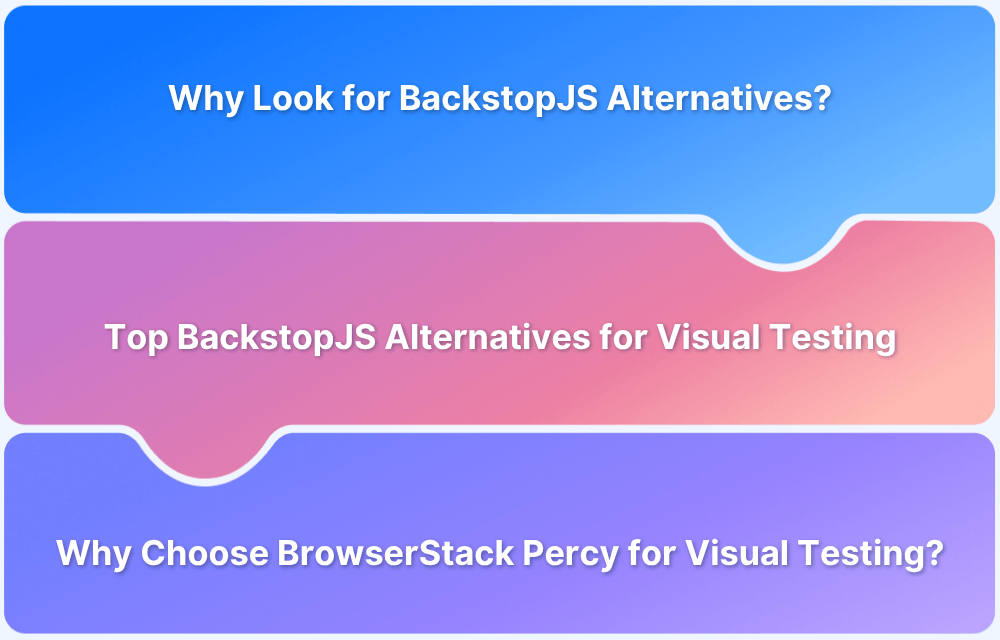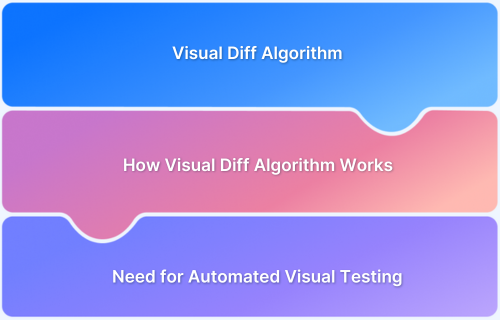BackstopJS is an open-source visual regression testing framework built on Node.js, known for its quick visual diffs and command-line flexibility. However, managing baselines, infrastructure, and reports manually can make it hard to scale for larger teams.
Overview
Top Alternatives to BackstopJS for Visual Testing:
- Percy by BrowserStack: AI-powered visual testing integrated with CI/CD, supporting web and mobile apps with noise filtering and cross-browser/device comparison.
- Katalon Visual Testing: Integrated visual validation within a full test automation suite, supporting cross-browser and cross-platform UI testing with no/low code.
- Mabl: Cloud-based, no-code AI visual testing with functional test integration, real-time analytics, and DevOps pipeline compatibility.
- TestGrid Visual Validation: Scriptless AI visual validation platform with real device testing, instant defect reporting, and enterprise CI/CD integrations.
- Screenster: Recording-based visual testing with pixel-perfect UI comparison and built-in bug tracking, compatible with CI/CD workflows.
- Applitools Eyes: A leading Visual AI tool offering intelligent visual monitoring, root cause analysis, and broad platform support including PDFs and images.
- VisualReview: Open-source, self-hosted visual regression platform supporting manual and automated image diff with API and review interface.
- testRigor: AI-powered scriptless test automation that includes advanced visual validation with contextual UI understanding and plain-English syntax.
- VisualEyes: AI-driven visual design validation tool with predictive eye-tracking and attention heatmaps integrated with design platforms like Figma.
- Galen Framework: Open-source tool for layout and responsive design testing with Selenium integration and visual structure validation.
- Argos-CI: Open-source GitHub-integrated visual testing tool that runs snapshot diffs in PR workflows with a simple visual diff interface.
- Needle: Python-based visual regression tool integrating with Selenium, offering lightweight screenshot comparison for Python-heavy projects.
This article explores the best BackstopJS alternatives that offer AI-powered stability, broader browser and device coverage, and collaborative, cloud-based workflows.
What is BackstopJS?
BackstopJS is a widely adopted, open-source framework used for visual regression testing of web frontends.
Written in JavaScript and built on Node.js, it operates by treating your web service as a black box and capturing visual diffs between a “before” and an “after” state of your UI (User Interface).
Key characteristics of BackstopJS include:
- Snapshot Testing: It compares a newly rendered page screenshot (test snapshot) against a previously approved reference snapshot.
- Headless Browser Engine: It is powered by headless Chrome (or other engines like Puppeteer/Playwright), making it effective at catching visual changes caused by CSS.
- Responsive Testing: The tool can test an assortment of different screen sizes and viewports, providing confidence in responsive design integrity.
- In-Browser Report: It generates a helpful HTML report with a visual diff interface (scrubber) to display the reference, test, and differences simultaneously for review.
Also Read:Snapshot Testing with Jest
Why Look for BackstopJS Alternatives?
While BackstopJS is free and customizable, its limitations present scaling and maintenance challenges for large or complex enterprise applications:
- Lack of AI-Powered Stability: It relies on pixel-based comparison and requires manual effort in adding delays, masking dynamic selectors, or using Docker to maintain a consistent environment, leading to frequent false positives in dynamic UIs.
- Limited Cross-Browser Coverage: BackstopJS historically relied on single headless browsers and often has limited native support for testing across all required WebKit, Firefox, or real mobile devices out of the box.
- No Centralized Collaboration: It lacks built-in features for a hosted dashboard, advanced analytics, baseline management, or collaboration tools needed for large teams to review and approve changes.
- Manual Infrastructure Management: Teams are responsible for setting up, configuring, maintaining, and potentially hosting the entire testing infrastructure, which is a drain on developer time.
- Visual-Only Scope: The tool excels at visual diffs but does not provide broader test coverage for functional, API, performance, or native mobile applications, requiring additional tools to fill these gaps.
Must Read:Automated Visual AI Testing
Top BackstopJS Alternatives for Visual Testing
Visual testing at scale requires capabilities beyond the open-source limitations of BackstopJS, particularly when dealing with dynamic UIs and cross-browser coverage.
The following are some of the top alternatives for visual testing that offer advanced solutions.
1. BrowserStack Percy
Percy by BrowserStack is an AI-driven visual testing solution built to automate visual regression testing for web applications, ensuring pixel-perfect user interfaces with every code update.
Seamlessly integrated into CI/CD pipelines, Percy uses advanced AI to detect meaningful layout shifts, style inconsistencies, and content updates, minimizing false positives and reducing review time for faster, more reliable releases.
- Effortless Visual Regression Testing: Integrates smoothly into CI/CD pipelines with just one line of code and supports Storybook, Figma, and functional test suites to enable true shift-left testing.
- Automated Visual Regression: Automatically captures screenshots on each commit, compares them with baselines, and highlights regressions such as layout breaks, style changes, or component issues.
- Visual AI Engine: Uses intelligent algorithms and AI agents to filter out visual noise from animations, dynamic elements, and anti-aliasing. Features like Intelli Ignore and OCR focus only on meaningful visual changes, significantly reducing false positives.
- Visual Review Agent: Highlights key UI changes with bounding boxes, generates easy-to-read summaries, and speeds up review cycles by up to 3x.
- No-Code Visual Monitoring: The Visual Scanner enables instant, code-free setup to monitor thousands of URLs across 3,500+ browsers and devices. Teams can schedule or trigger scans, exclude dynamic regions, and compare environments like staging and production instantly.
- Flexible Monitoring: Schedule visual scans at set intervals, analyze historical trends, and detect issues proactively. Supports local environments, authenticated pages, and comprehensive environment comparisons.
- Broad Integrations: Compatible with major CI/CD tools and frameworks, offering SDKs for quick onboarding and scalable automation.
App Percy extends BrowserStack’s visual testing capabilities to native iOS and Android apps. It runs tests on a cloud of real devices to ensure precise UI consistency, while AI intelligently manages dynamic elements to minimize flaky tests and false positives.
With simple, one-line setup, App Percy integrates effortlessly with popular frameworks such as Appium, WebdriverIO, Java, and Python, enabling faster, scalable, and reliable mobile visual testing.
2. Katalon Visual Testing
Katalon Visual Testing offers visual validation embedded within a full-featured, no/low-code automation platform suitable for cross-browser and mobile UI testing.
Key Features:
- Visual checkpoints within automated tests
- Cross-browser and device support
- Easy no-code scripting options
Verdict: Ideal for teams wanting combined functional and visual testing with minimal coding but cannot provide advanced AI noise filtering.
Must Read: Katalon Alternatives
3. Mabl
Mabl delivers no-code, AI-powered visual regression integrated with functional testing and real-time analytics within DevOps pipelines.
Key Features:
- Automated visual diffs with AI noise suppression
- No-code test creation and maintenance
- DevOps and CI/CD integration
Verdict: Perfect for product teams needing rapid visual/functional testing insights but cannot handle complex custom visual validation.
Must Read: Mabl Alternatives
4. TestGrid Visual Validation
TestGrid is a scriptless AI visual validation platform offering real-device testing and instant defect reports with enterprise CI/CD tool compatibility.
Key Features:
- Scriptless visual test creation
- Real device cloud testing
- Defect reporting dashboard
Verdict: Good for quick setup with real-device support yet cannot provide deep scripting customizations.
5. Screenster
Screenster simplifies visual regression with recording-based test creation, pixel-perfect UI comparisons, and integrated bug tracking for seamless CI/CD.
Key Features:
- Visual test recording and playback
- Pixel-level diffing and bug tracking
- CI/CD pipeline compatibility
Verdict: Uses a simple visual approach suitable for fast onboarding but lacks advanced AI-driven noise filtering.
6. Applitools Eyes
Applitools Eyes is a premier Visual AI testing platform offering precise visual monitoring, root cause analysis, and support for various UI formats beyond web.
Key Features:
- AI-based visual validation mimicking human perception
- Root cause analysis with detailed diagnostics
- Broad platform support (web, mobile, PDFs, images)
Verdict: Excellent for enterprises needing broad UI format support but often comes with higher cost and complexity.
7. VisualReview
VisualReview is an open-source, self-hosted platform supporting automated and manual visual regression with a user-friendly review interface and API access.
Key Features:
- Manual and automated diff workflows
- REST API for easy integration
- On-premises deployment for security
Verdict: Best for teams needing full test environmentcontrol but not suited for large-scale cloud-based testing.
8. testRigor
testRigor offers AI-powered, scriptless test automation with advanced visual validation capabilities across web and mobile platforms using plain-English commands.
Key Features:
- AI contextual UI understanding
- OCR-enabled visual validations
- Easy plain-English test creation
Verdict:Great for non-technical teams and cross-platform testing but limited in complex script customization.
9. VisualEyes
VisualEyes applies AI-driven predictive eye-tracking and attention mapping for design validation integrated with design tools like Figma.
Key Features:
- Predictive eye-tracking heatmaps
- Design visibility and impact analysis
- Integration with Figma and Sketch
Verdict: Ideal for early design validation to improve UX but cannot replace functional or automated UI testing.
Also Read: UI Automation : Everything you need to know
10. Galen Framework
Galen Framework is an open-source tool for layout and responsive design testing, integrating with Selenium for detailed visual structure validation.
Key Features:
- Layout validation rules and spatial checks
- Responsive breakpoint testing
- Integration with Selenium and CI systems
Verdict: Perfect for responsive design validation but lacks pixel-perfect visual regression and AI features.
11. Argos-CI
Argos-CI is an open-source visual testing tool integrated with GitHub that performs snapshot diffs during pull request workflows.
Key Features:
- GitHub PR snapshot diffing
- Simple visual diff interface
- Easy integration with static site generators
Verdict: Excellent for teams using GitHub workflows but cannot handle dynamic or complex application UIs.
12. Needle
Needle is a Python-based visual regression testing tool integrated with Selenium, designed for lightweight image comparisons in Python environments.
Key Features:
- Python-based image diffing
- Selenium integration for UI automation
- Lightweight and scriptable
Verdict: Good for Python-centric teams needing basic visual comparisons but lacks advanced AI or cross-platform features.
Read More: Visual Regression Testing Tools Compared
Why Choose BrowserStack Percy for Visual Testing?
BrowserStack Percy delivers AI-powered visual regression testing with intelligent noise filtering, dramatically reducing false positives compared to BackstopJS’s basic pixel-by-pixel approach.
Percy integrates seamlessly with modern CI/CD pipelines and supports multiple frameworks along with real browsers and devices via BrowserStack’s cloud. In contrast, BackstopJS mainly targets Chrome and requires manual Storybook configuration.
Key Advantages of Percy:
- AI-Driven Accuracy: Detects only meaningful UI changes, avoiding noise and false alerts.
- Cross-Browser & Responsive Testing: Works across browsers, devices, and breakpoints out-of-the-box.
- Collaborative Dashboard: Centralized review, approval, and management of visual changes for teams.
- Zero Maintenance: Cloud-based platform removes the setup and upkeep needed for open-source tools.
- Seamless Integration: Connects effortlessly with CI/CD and popular test frameworks.
Conclusion
While BackstopJS provides an excellent, free foundation for visual regression testing, its manual infrastructure management, limited browser support, and lack of collaboration features constrain enterprise adoption.
Moving to alternatives like BrowserStack Percy provides crucial advantages that allow teams to scale visual checks with speed and confidence.
Useful Resources for Visual Testing
- How to capture Lazy Loading Images for Visual Regression Testing in Cypress
- How to Perform Visual Testing for Components in Cypress
- How to run your first Visual Test with Cypress
- How Visual Diff Algorithm improves Visual Testing
- How is Visual Test Automation changing the Software Development Landscape?
- How does Visual Testing help Teams deploy faster?
- How to perform Visual Testing for React Apps
- How to Run Visual Tests with Selenium: Tutorial
- How to reduce False Positives in Visual Testing?
- How to capture Lazy Loading Images for Visual Regression Testing in Puppeteer
- How to migrate your Visual Testing Project to Percy CLI
- Why is Visual Testing Essential for Enterprises?
- Importance of Screenshot Stabilization in Visual Testing
- Strategies to Optimize Visual Testing
- Best Practices for Visual Testing
- Visual Testing Definitions You Should Know
- Visual Testing To Optimize eCommerce Conversions
- Automate Visual Tests on Browsers without Web Drivers
- Appium Visual Testing: The Essential Guide
- Top 17 Visual Testing Tools







